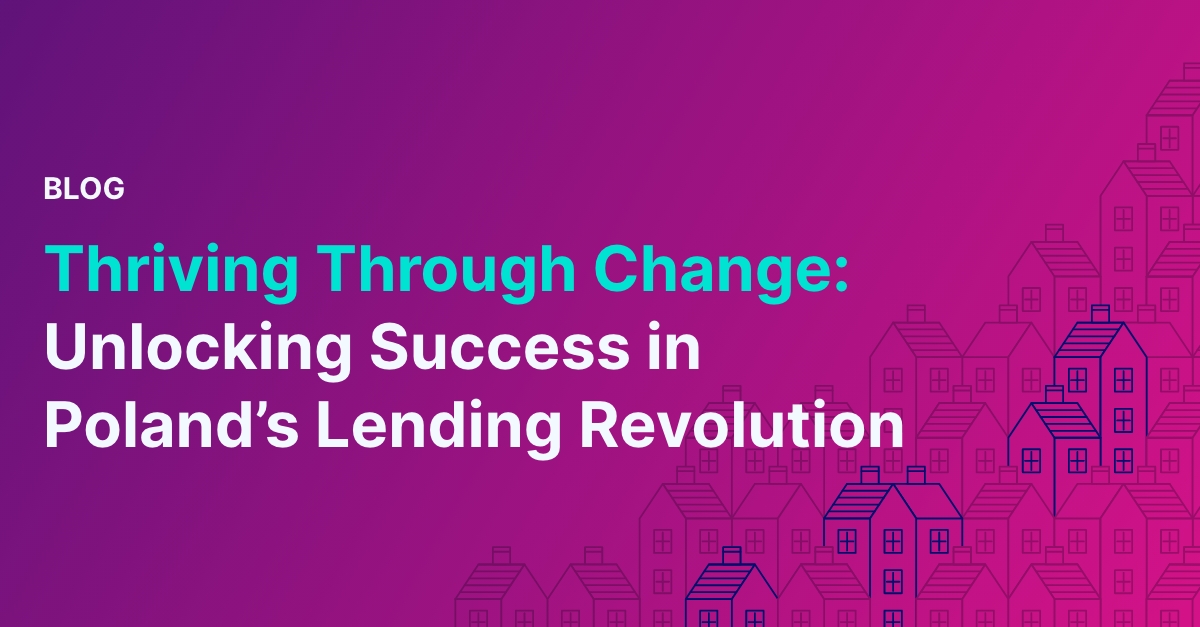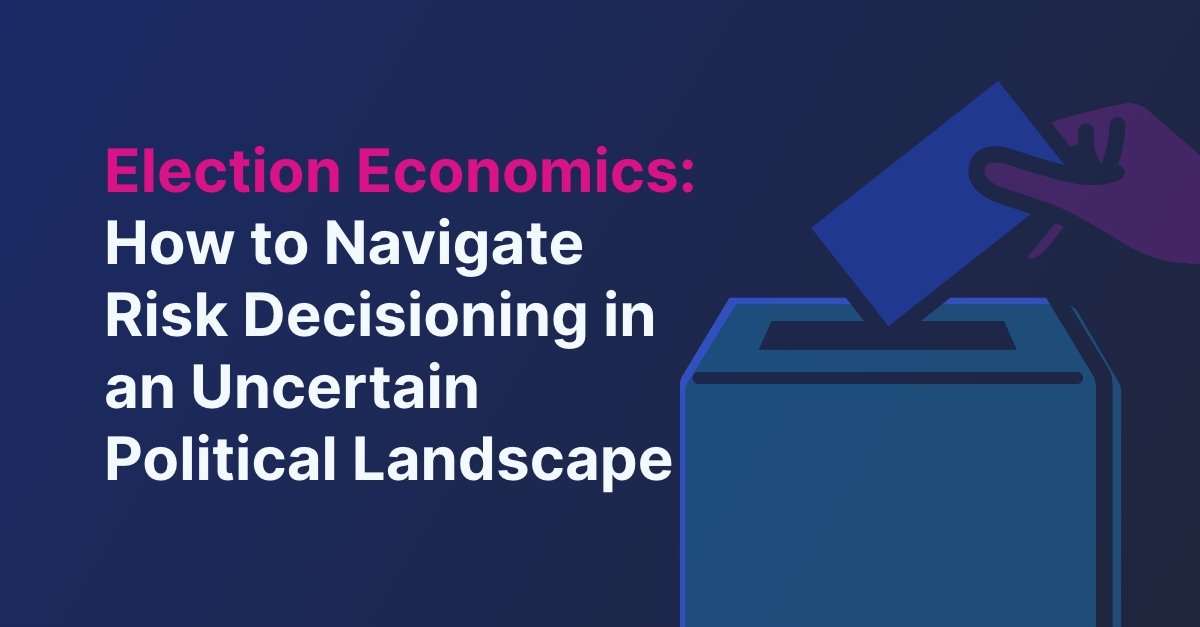BLOG: Unlocking Success in Poland’s Lending Revolution
Thriving Through Change: Unlocking Success in Poland’s Lending Revolution
-
Mark Collingwood
Poland’s economic landscape is undergoing significant change, with rising inflation and interest rates (as of December 2024, the annual inflation rate increased from 4.7% to 4.8% the month before, indicating persistent inflationary pressures). Likewise, mortgage interest rates are also on the rise, with the average rate in the country reaching 7.16% in late 2024, up from just 2.27% in December of 2022. While this economic shift presents both challenges and opportunities for lenders in Poland, one thing is clear – to navigate this evolving environment successfully, financial services providers must look to innovative and agile approaches that address changing borrower needs while still effectively mitigating risk. In this blog, we’re looking more closely at this shift, and how you can ensure your business thrives amidst uncertainty.
The Impact of Economic Shifts on Lending in Poland
There’s notable turbulence in Poland’s economy, driven by persistently high inflation and elevated interest rates. At the end of last year, inflation remained high, impacting consumer purchasing power and financial stability. And mortgage rates, which have exceeded 7% for many borrowers, adds further strain to household budgets, making lending challenging for both consumers and lenders. With rising costs like this, potential homebuyers are forced to reassess affordability, which then has the domino effect of slowing down the mortgage market and reshaping the overall lending landscape.
On top of economic pressures, the regulatory environment in Poland is tightening its grip to ensure financial stability. The Polish Financial Supervision Authority (KNF) plays a pivotal role, introducing policies to strengthen risk management and promote financial resilience. Some of these initiatives include enhanced creditworthiness assessments and stricter compliance measures, with the aim to mitigate systemic risks while encouraging responsible lending practices.
But these regulations can present operational challenges for lenders. Balancing regulatory compliance with providing accessible, competitive loan products can be tricky – highlighting the importance of both efficiency and innovation in navigating lending in complex economic situations. Collaboration with regulatory bodies, paired with strategic investments in decisioning technology, will be essential for lenders who want to future-proof their lending strategy.
Evolving Borrower Dynamics: Embracing Flexibility and Digital Innovation to Stay Competitive
Borrowers in Poland are increasingly seeking alternative financing solutions that provide greater flexibility and personalization. Traditional, rigid lending structures are out. Instead, driven by consumers’ desire for financial products that align with their own unique needs and circumstances, budget-conscious borrowers are now prioritizing loan options that offer more adaptable terms and personalized services. To meet these shifting demands, you have to embrace the opportunity to develop and offer:
-
Flexible Loan Products: Options like adjustable-rate mortgages and payment holidays help borrowers seeking more adaptable repayment plans.
-
Personalized Financial Solutions: Tailor loan offerings to individual borrower profiles to enhance customer satisfaction and loyalty.
-
Digital Accessibility and User-Friendly Platforms: Invest in intuitive digital platforms, keeping in mind the implementation of the European Accessibility Act (EAA), which mandates accessibility requirements for products and services (including digital interfaces).
How do you accomplish this? By leveraging advanced technologies, especially artificial intelligence (AI) and machine learning (ML), to transform your credit assessment and fraud detection processes.
AI-driven systems can process vast amounts of financial data in real time, utilizing advanced ML algorithms to identify patterns and anomalies that indicate a borrower’s potential credit risk. Predictive models can analyze spending behavior, transaction history, and even social media data, enabling more accurate credit risk assessments – and more informed lending decisions.
And when it comes to that ever-present thorn in the side of lenders everywhere, fraud, AI/ML offers critical help. Analyzing extensive datasets quickly allows these systems to detect unusual patterns and behaviours that can signal fraudulent activity, allowing for prompt intervention. Fraud detection strategies that incorporate AI have even been shown to improve accuracy in distinguishing between human errors and genuine fraud attempts, reducing unnecessary interventions and false alarms (and saving you time and people-power in the process).
Using advanced technologies like AI/ML is helping to drive digital transformation in lending, and allows for more customer-centric processes:
-
Adoption Rates: Poland is leading central Europe’s digital transformation, with many financial institutions having invested in digital transformation initiatives, recognizing the importance of digital transformation and reflecting a commitment to modernizing operations and enhancing service delivery.
-
Rise of Digital Banking: Digital banking has become the primary channel for financial transactions for many Poles. In 2024, online banking penetration in Poland reached 65%.
-
Successful Digital Lending Initiatives: Poland has witnessed the emergence of innovative digital lending platforms that streamline the borrowing process. For instance, the mobile payment system BLIK allows users to make instant payments and withdraw cash using their standard mobile banking app, enhancing the efficiency and convenience of financial transactions.
-
Streamlining Loan Applications and Approvals: The adoption of AI and digital platforms has revolutionized the loan application process. Automated systems enable quicker approvals by efficiently analyzing applicant data, reducing the time from application to disbursement.
-
Building Trust and Engagement: User-friendly digital platforms enhance customer experience, fostering trust and engagement. Features like personalized dashboards, real-time notifications, and responsive customer service contribute to higher customer satisfaction and loyalty.
Embracing strategies like these will allow you to position yourselves more competitively – all while you enhance operational efficiency, improve risk management, and deliver superior customer experiences.
Riding the Risk Wave: Smart Strategies for Lending Success in Poland
The strain that high inflation and interest rates places on borrowers increases the risk of loan defaults, whether those loans are mortgages or otherwise. When things are shifting, reactive strategies are no longer sufficient. But adopting a more proactive risk management approach, powered by advanced technologies and strategic partnerships, can help you get (and stay) ahead of these pressures:
-
Strengthen Borrower Assessments
Enhance underwriting processes by integrating AI-driven tools that evaluate real-time borrower data for more accurate risk profiling. -
Offer Flexible Repayment Options
Payment holidays or loan restructuring options can support borrowers facing temporary financial challenges, helping to prevent defaults. -
Adopt Early Warning Systems
Proactive monitoring of repayment behaviors can flag potential issues early, allowing for timely interventions and tailored borrower support. -
Real-Time Analytics and Predictive Modelling
Tools like Provenir’s AI Decisioning platform empower lenders with the ability to analyze data streams in real-time, identify emerging risks, and predict future trends. This enables precise adjustments to lending strategies before problems escalate.
-
Balance Growth with Risk Mitigation
Sustainable growth requires a dual focus on expanding lending portfolios while maintaining robust risk controls. Leveraging predictive analytics ensures lenders can scale responsibly without exposing themselves to unnecessary risks.
-
Partner With Technology Providers
Partnerships with tech companies drive innovation, offering solutions for automating credit assessments, fraud detection, and compliance processes. -
Regulatory Collaboration
Working with regulatory bodies, such as the Polish Financial Supervision Authority (KNF), ensures compliance with evolving rules and builds trust with stakeholders.
KNF Initiatives
The KNF is spearheading efforts to enhance Poland’s financial infrastructure, ensuring the industry can adapt to current challenges:
Rising to the Occasion: Lending Strategies for Poland’s Future
There is a lot of positivity on the horizon for Poland – the outlook for 2025 is strong, with the Organisation for Economic Co-operation and Development (OECD) projecting a GDP growth rate of 2.4%. This expansion will help invigorate the lending market, and the country’s digital economy is already on a rapid ascent, thanks to the widespread adoption of e-commerce, mobile payments, and online banking tech. The digital economy is predicted to reach $87 billion this year, and over $130 billion by 2030. With a tech-savvy population that is increasingly looking for innovative financial solutions, the runway of opportunity for lenders that adapt to these preferences is long and healthy.
To fully take advantage of what digital transformation in Poland has to offer, consider these strategies:
-
Stay Agile in Adapting to Economic and Regulatory Changes:
The dynamic nature of Poland’s economy and regulatory environment means you need to remain flexible and responsive. Implementing adaptive business models and staying informed about policy shifts are crucial for sustained success. -
Leverage Technology to Prioritize Customer Needs and Experiences:
Embracing digital tools can enhance customer interactions and streamline operations. For instance, the rise of neobanking in Poland is projected to grow by 10.86% between 2025 and 2028, reaching a market volume of $35.82 billion by 2028.
This trend underscores the importance of digital accessibility and user-friendly platforms in meeting customer expectations. -
Develop Sustainable, Customer-Focused Lending Practices:
Offering personalized financial products that cater to individual borrower profiles can foster customer loyalty and drive growth. Flexible loan options and transparent communication are key components of a customer-centric approach.
Poland’s lending market presents a challenging yet promising landscape. Lenders who embrace digital transformation, proactively manage risk, and prioritize borrower-centric innovation will not only navigate economic uncertainties but also seize opportunities for growth. One of the best measures of future-proofing success? The right technology partner.
Provenir’s AI Decisioning platform is uniquely positioned to empower lenders in Poland to thrive in this dynamic environment. By harnessing the power of AI and machine learning, our platform enhances fraud detection, streamlines credit risk assessment, and delivers real-time insights to help you make faster, more informed decisions.



























